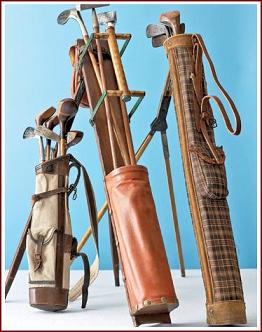Vintage Golf Bags: The Craftsmanship and Styles of the Past
Posted by Knicks, Links, & Inks Publishing on Jul 1st 2023
Golf has a rich history filled with tradition and elegance, and few items embody this legacy better than vintage golf bags. These bags were more than just functional carriers for clubs; they were crafted with meticulous attention to detail, using high-quality materials and showcasing an artistry that has evolved over the decades. We'll explore the history, craftsmanship, and styles of traditional golf bags, and how they compare to the modern designs we see on the course today.
The Early Days: The Birth of Golf Bags
In the late 19th and early 20th centuries, as golf gained popularity, the need for a practical way to carry clubs became evident. The earliest golf bags were simple canvas or leather tubes with a single strap. Their primary purpose was functional: to transport clubs easily.
Early Materials and Design
- Canvas and Leather: The first golf bags were made from sturdy materials like canvas and leather, chosen for their durability.
- Basic Construction: These early designs were rudimentary, often lacking pockets or dividers. They were essentially cylindrical sacks with a strap, designed to be slung over the shoulder.
The Golden Age: 1920s to 1950s
As the sport of golf continued to grow, so did the sophistication of golf bags. The period between the 1920s and 1950s is often considered the golden age of golf bag craftsmanship.
Craftsmanship and Materials
- Leather Craftsmanship: Leather golf bags became the standard, prized for their durability and classic look. Skilled artisans would handcraft each bag, ensuring high quality and attention to detail.
- Reinforcements: To enhance durability, leather bags were often reinforced with metal or wooden frames, preventing them from collapsing and providing better protection for the clubs.
Functional Enhancements
- Multiple Pockets: Golf bags from this era began to feature multiple pockets, allowing golfers to carry balls, tees, and personal items.
- Club Dividers: Dividers were introduced to keep clubs organized and prevent them from banging into each other.
Aesthetic Appeal
- Classic Designs: The aesthetics of golf bags during this time were simple yet elegant, with minimalistic designs that exuded class. Embossed logos and personalized monograms were common, adding a touch of individuality.
The Modern Era: 1960s to Today
The advent of new materials and manufacturing techniques in the 1960s and beyond revolutionized golf bag design. While the craftsmanship of vintage bags is still celebrated, modern bags offer a range of features that cater to the needs of today's golfers.
Innovations in Materials
- Synthetic Fabrics: Modern golf bags are often made from lightweight, durable synthetic materials like nylon and polyester, which are more resistant to the elements.
- Waterproofing: Advances in waterproofing have made modern bags more practical for all-weather play, protecting clubs and gear from rain and moisture.
Enhanced Functionality
- Advanced Pockets: Today's golf bags feature an array of specialized pockets, including insulated compartments for drinks, lined pockets for valuables, and large compartments for apparel.
- Integrated Stands: Stand bags with integrated legs allow golfers to easily set their bags upright on the course, providing convenience and ease of access.
Ergonomic Design
- Comfortable Straps: Modern bags often come with padded, adjustable straps and ergonomic designs that distribute weight evenly, reducing strain on the shoulders and back.
- Lightweight Construction: Advances in materials and design have led to significantly lighter golf bags, making them easier to carry over long rounds.
Technological Features
- GPS and Battery Pockets: Some high-end modern bags come equipped with pockets designed for GPS devices and portable chargers, integrating technology into the golfing experience.
- Modular Systems: Customizable modular systems allow golfers to add or remove pockets and accessories based on their needs.
Comparing Vintage and Modern Golf Bags
While modern golf bags offer unparalleled convenience and functionality, vintage golf bags hold a special place in the hearts of many golfers and collectors.
Craftsmanship vs. Convenience
- Artisanal Quality: Vintage golf bags are admired for their handcrafted quality and the skilled artisanship that went into making each one. The leather and metalwork are often considered pieces of art.
- Modern Efficiency: Modern bags, on the other hand, prioritize convenience, lightweight design, and weather resistance, making them more practical for everyday use.
Style vs. Functionality
- Classic Elegance: The classic elegance of vintage bags, with their rich leather and minimalist design, offers a timeless aesthetic that many golfers appreciate.
- High-Tech Features: Modern bags provide high-tech features and enhanced functionality that cater to the demands of contemporary golfers, who often carry a range of accessories and gadgets.
Collectibility and Nostalgia
- Vintage Appeal: For collectors and enthusiasts, vintage golf bags represent a nostalgic connection to the history and tradition of the game. They are often sought after for their historical value and unique designs.
- Modern Utility: Modern bags are prized for their utility and performance, providing golfers with the tools they need to play their best game.
The evolution of golf bags from the early leather brogues to today's high-tech designs reflects the broader changes in golf equipment and the sport itself. While modern bags offer unmatched functionality and convenience, vintage golf bags remain cherished for their craftsmanship, style, and connection to the rich history of golf. Whether you're a collector, a traditionalist, or a modern golfer, the significance of golf bags in the game is undeniable. They are more than just carriers for clubs; they are symbols of the sport's enduring legacy and its continuous evolution.



